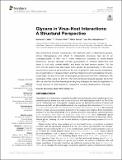Glycans in Virus-Host Interactions: A Structural Perspective
Author(s)
Miller, Nathaniel L.; Clark, Thomas; Raman, Rahul; Sasisekharan, Ram
DownloadPublished version (1.179Mb)
Publisher with Creative Commons License
Publisher with Creative Commons License
Creative Commons Attribution
Terms of use
Metadata
Show full item recordAbstract
Many interactions between microbes and their hosts are driven or influenced by glycans, whose heterogeneous and difficult to characterize structures have led to an underappreciation of their role in these interactions compared to protein-based interactions. Glycans decorate microbe glycoproteins to enhance attachment and fusion to host cells, provide stability, and evade the host immune system. Yet, the host immune system may also target these glycans as glycoepitopes. In this review, we provide a structural perspective on the role of glycans in host-microbe interactions, focusing primarily on viral glycoproteins and their interactions with host adaptive immunity. In particular, we discuss a class of topological glycoepitopes and their interactions with topological mAbs, using the anti-HIV mAb 2G12 as the archetypical example. We further offer our view that structure-based glycan targeting strategies are ready for application to viruses beyond HIV, and present our perspective on future development in this area.
Date issued
2021-06Department
Massachusetts Institute of Technology. Department of Biological Engineering; Koch Institute for Integrative Cancer Research at MITJournal
Frontiers in Molecular Biosciences
Publisher
Frontiers Media SA
Citation
Miller, Nathaniel L. et al. "Glycans in Virus-Host Interactions: A Structural Perspective." Frontiers in Molecular Biosciences 8 (June 2021): 666756.
Version: Final published version
ISSN
2296-889X